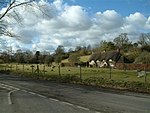Fyfield Down
Hills of WiltshireSites of Special Scientific Interest in WiltshireSites of Special Scientific Interest notified in 1951

Fyfield Down (grid reference SU136709) is part of the Marlborough Downs, about 1.5 miles (2.4 km) north of the village of Fyfield, Wiltshire. The down is a 325.3 hectare biological and geological Site of Special Scientific Interest, notified in 1951. The down has the best assemblage of sarsen stones in England, known as the Grey Wethers. The site is to be distinguished from another Fyfield Down also in Wiltshire, east of Pewsey and on the edge of Salisbury Plain, near another place called Fyfield. The two places are only about 9 miles (14 km) apart.
Excerpt from the Wikipedia article Fyfield Down (License: CC BY-SA 3.0, Authors, Images).Fyfield Down
Herepath,
Geographical coordinates (GPS) Address Nearby Places Show on map
Geographical coordinates (GPS)
| Latitude | Longitude |
|---|---|
| N 51.4369 ° | E -1.8057 ° |
Address
Herepath (Green Street)
Herepath
SN8 1RU , Fyfield
England, United Kingdom
Open on Google Maps










